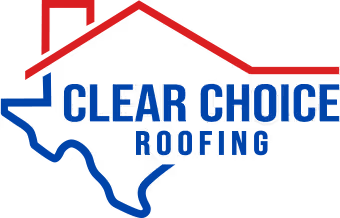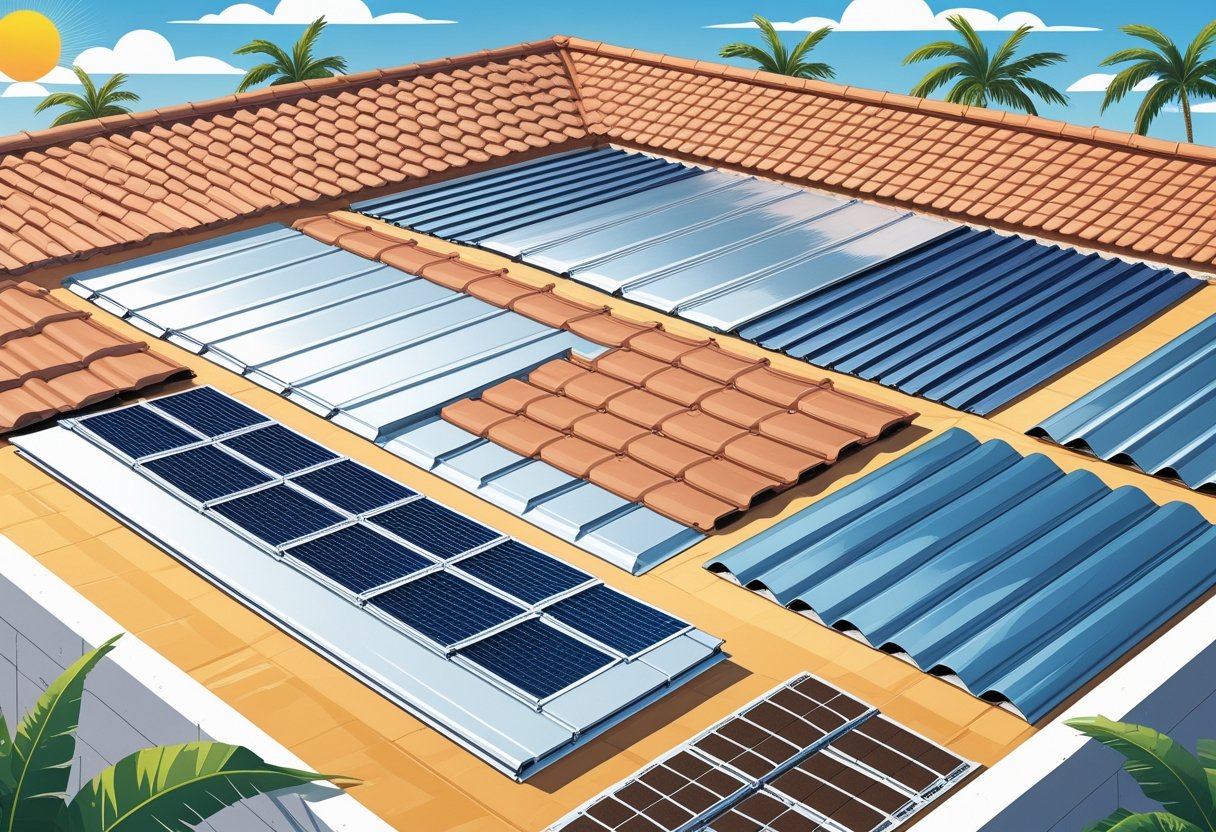Choosing the right roofing material for hot climates is essential to keeping your home cool and energy-efficient. The best roofing materials for hot climates are those that reflect sunlight, resist heat, and provide long-lasting durability, such as metal, clay, concrete tiles, and slate. These materials reduce heat absorption and help lower cooling costs over time.
With the intense heat common in places like Austin, your roof plays a critical role in protecting your property and maintaining comfort. At Clear Choice Roofing, we understand the unique demands of hot-weather roofing and use only high-grade materials suited to withstand extreme temperatures while offering excellent insulation.
By selecting a roofing material designed for hot climates, you can avoid heat buildup and extend the life of your roof. Whether you want energy savings or enhanced durability, Clear Choice Roofing can help you choose and install the ideal roofing system that matches your home’s needs. For more details on roofing materials for hot climates, visit the guide on best roofing materials for hot climates.
What Makes a Roofing Material Ideal for Hot Climates?
When selecting roofing materials for hot climates, you want options that reduce heat gain, resist damage from intense sun, and improve energy efficiency. Key factors include how well the roof reflects sunlight, manages heat flow, supports airflow, and maintains durability over time.
Reflectivity and Solar Reflectance
Solar reflectance measures how much sunlight a roofing material reflects rather than absorbs. High reflectance lowers roof surface temperatures and reduces cooling costs by limiting heat transfer into your home.
Materials with light colors or special reflective coatings perform best here. For instance, white or light-colored metal roofs and specially coated shingles reflect more solar energy, keeping interiors cooler.
Reflectivity is often paired with thermal emittance, which is how well the roof radiates absorbed heat away. Together, these properties help create “cool roofs” that improve energy savings by reducing the burden on your air conditioning system.
Thermal Mass and Heat Transfer
Thermal mass describes a material’s ability to absorb, store, and slowly release heat. In hot climates, roofing materials with lower thermal mass, like metal and clay tiles, prevent excessive heat buildup during the day.
Materials such as slate or concrete tile have higher thermal mass. These can be effective if paired with proper ventilation, as they absorb heat but do not release it quickly at night, potentially keeping your home warmer.
Minimizing heat transfer through insulation and roofing choice is critical. Your roofing should act as a barrier, reducing heat flow into your living spaces. Clear Choice Roofing emphasizes combining appropriate materials with expert installation to optimize heat transfer resistance.
Ventilation and Airflow
Good ventilation systems under and within the roof structure help dissipate trapped heat and moisture. This airflow reduces cooling loads and extends the roof’s lifespan.
Ridge vents, soffit vents, and attic fans create continuous airflow, preventing hot air pockets that increase indoor temperatures. Proper ventilation also reduces the risk of premature material degradation due to heat stress.
In hot and humid environments, combining ventilation with energy-efficient roofing materials amplifies cooling effects. Effective ventilation lowers attic temperatures by up to 30%, leading to noticeable energy savings.
Durability and Longevity
Heat, UV rays, and occasional storms in hot climates place heavy stress on roofing materials. You need roofing options designed to resist cracking, fading, warping, and other damage caused by extreme heat exposure.
Materials like metal, slate, and clay tiles are renowned for their durability and long lifespans. Synthetic roofing products engineered for heat resistance also provide robust performance with low maintenance.
Durability extends beyond materials to installation quality. Clear Choice Roofing ensures every roof is installed with industry-best practices and premium materials to withstand Austin-area heat and weather while protecting your investment for decades.
Top Roofing Materials for Hot Weather
Choosing roofing materials that withstand high temperatures and reflect sunlight can help keep your home cooler and reduce energy costs. Durability and heat resistance are crucial factors, along with maintenance needs. Selecting the right roofing also depends on your budget and style preferences, but some materials consistently perform well in hot climates.
Metal Roofing
Metal roofing is highly durable and excellent at reflecting solar heat, which helps lower indoor temperatures. Its light-colored or reflective coatings further improve energy efficiency by bouncing sunlight away. Metal roofs resist cracking, warping, and fire, making them a reliable choice for hot weather.
Installation is generally quicker than other materials, and metal roofs can last 40 to 70 years with proper care. However, they can be noisier during rain or hail without adequate insulation. If you want a low-maintenance option that stands up to extreme heat, metal roofing is worth considering. For expert installation services, Clear Choice Roofing provides professional metal roof solutions tailored for hot climates.
Clay and Terracotta Tiles
Clay and terracotta tiles offer excellent heat resistance due to their ability to absorb and release heat slowly. These tiles have natural thermal properties that help regulate temperature fluctuations, keeping your home cooler during the day. Their durability allows them to last 50 years or more with minimum upkeep.
They also provide excellent ventilation due to the way they are installed, creating air gaps that reduce heat buildup. Clay and terracotta tiles are heavy, so your roof structure must support the added weight. These tiles add a classic look and are resistant to fire and insect damage. For homeowners seeking long-lasting, stylish, and heat-resistant roofing materials, clay tile roofing is a proven choice.
Slate Roofing
Slate roofing consists of natural stone tiles that excel at heat resistance and durability. Slate can last well over a century, making it the longest-lasting roofing material available. Its dense structure helps reflect heat and withstand harsh sun exposure without fading or cracking.
Slate is fire-resistant and requires little maintenance, but it is one of the more expensive options and also quite heavy. Installation demands experienced professionals to ensure long-term performance. Your investment in slate roofing can provide a refined appearance while effectively managing extreme heat. Clear Choice Roofing can help you select and install slate roofing that meets your climate challenges and aesthetic goals.
Synthetic and Rubber Roofing
Synthetic roofing materials, including rubber roofing, combine durability with lightweight construction. These materials often incorporate UV-resistant coatings that repel heat and protect the roof surface from sun damage.
Rubber roofing, typically made from recycled materials, is flexible and resists cracking under temperature changes. It usually comes with reflective finishes to enhance energy efficiency. Synthetic options also tend to be easier and faster to install compared to heavier roofing materials like clay or slate. These roofing materials provide budget-friendly, heat-tolerant alternatives with a variety of styles and colors to match your home’s look.
For hot climate roofing that balances cost, performance, and maintenance, synthetic and rubber roofing are practical solutions with growing popularity.
Energy-Efficient and Cool Roofing Options
Choosing roofing materials that reflect sunlight and limit heat absorption can significantly lower cooling costs in hot climates. Incorporating technologies that enhance reflectivity and thermal emittance will help keep your indoor spaces cooler and reduce energy use.
Cool Roof Coatings and Technologies
Cool roof coatings improve energy efficiency by reflecting more sunlight and increasing thermal emittance. These coatings are often applied to asphalt shingles or metal roofs, turning conventional roofing materials into cool roofs.
You can expect coatings in white or light colors designed to reflect ultraviolet and infrared light, which reduces heat buildup. This decreases the need for air conditioning, lowering energy bills during hot months.
Cool roofs are especially effective on buildings with low insulation but can provide energy savings on many types of roofs. At Clear Choice Roofing, we apply premium cool roof coatings to optimize your roof’s performance in Austin’s heat, ensuring long-term durability and energy savings.
Solar Panels and Green Roofs
Solar panels serve a dual purpose by generating electricity and absorbing sunlight that would otherwise heat your roof. When installed correctly, they reduce roof surface temperatures and energy consumption simultaneously.
Green roofs, which feature layers of vegetation, provide natural insulation and cooling. They absorb less heat than traditional roofs and help reduce urban heat island effects while improving air quality.
Both options require a structural evaluation before installation. Solar panels often work best integrated with other energy-efficient roofing techniques, while green roofs need adequate waterproofing and drainage. These solutions can be part of a comprehensive strategy to manage energy use effectively.
Light-Colored and Reflective Surfaces
Light-colored roofing materials like white clay tiles, reflective asphalt shingles, and concrete tile have high solar reflectance. These surfaces bounce back a large portion of sunlight, minimizing heat transfer into the building.
The effectiveness of light-colored roofs depends on two factors: reflectivity (how much sunlight is reflected) and thermal emittance (how well heat is radiated back away from the roof). Materials with both high reflectivity and emittance offer better cooling performance.
Clear Choice Roofing recommends selecting roofing materials that meet ENERGY STAR ratings for cool roofs to maximize energy savings specific to your home’s location and climate. Properly chosen reflective surfaces can lower interior temperatures without sacrificing durability or aesthetics.
Comparing Durability and Maintenance Needs
When selecting roofing materials for hot climates, you want options that can withstand intense heat, resist damage over time, and require manageable upkeep. Understanding the lifespan, weather challenges, and maintenance practices will help you make a well-informed choice for your home.
Lifespan of Hot Climate Roofing Materials
Roofing materials suited for hot climates vary widely in their durability. Metal roofs often last between 40 to 70 years, resisting heat and expanding less under sun exposure. Clay and concrete tiles can endure for 50 years or more, thanks to their natural heat resistance.
Asphalt shingles typically offer a shorter lifespan of 15 to 30 years but are more affordable. Synthetic roofing, like polymer-based tiles or slate alternatives, can provide a lifespan between 30 and 50 years, balancing durability and weight.
Your choice should factor in both upfront cost and long-term performance. Clear Choice Roofing installs high-grade materials suited to Texas heat, helping you select options that offer extended durability without excessive maintenance.
Weather Resistance and Upkeep
Roofing materials for hot climates must resist cracking, warping, and UV damage. Metal roofs reflect sunlight well, preventing heat absorption and lowering your cooling costs. However, metal can dent from hail or heavy debris, which requires occasional inspection.
Clay and concrete tiles excel at heat deflection, but their brittle nature means they can crack under impact or rapid temperature changes. Asphalt shingles may deteriorate faster under constant sun and need replacement sooner.
Proper ventilation and insulation underneath your roofing material improve resistance to heat stress and reduce wear. Clear Choice Roofing emphasizes proper installation techniques that maximize weather resistance while minimizing future repairs.
Maintenance Tips for Longevity
Routine maintenance is essential to extend the life of roofing materials in hot climates. Regularly inspect your roof for cracked or loose tiles, rust spots on metal, and granule loss on asphalt shingles.
Clean debris such as leaves, branches, or dust frequently to avoid moisture buildup and pest issues. Ensure gutters and downspouts are clear, as poor drainage can cause damage.
Applying protective coatings can enhance UV resistance, especially on metal and tile roofs. Scheduling professional inspections every 2 to 3 years helps catch minor problems early, saving you costly repairs down the line. Clear Choice Roofing offers maintenance services that keep your roof performing optimally in harsh heat conditions.
Ventilation Solutions for Hot Climate Roofs
Effective ventilation is essential to keep your roof and home cooler in hot climates. Proper airflow reduces heat buildup in the attic, lowers cooling costs, and prevents damage to roofing materials over time. Two key ventilation components work together to maintain balanced air movement through your roof system.
Soffit Vents and Ridge Vents
Soffit vents are installed under the eaves and allow cool air to enter the attic space. This intake of fresh air is vital to push out hot air that accumulates near the roof deck. Ridge vents run along the peak of the roof and act as exhaust points, letting hot, moist air escape naturally.
Using soffit and ridge vents in combination creates a continuous airflow cycle, preventing heat buildup and moisture retention. This type of ventilation system is passive, requiring no electricity, and is highly effective in managing attic temperatures. When installed correctly, it can extend the life of your roofing materials and reduce the strain on your air conditioning.
At Clear Choice Roofing, we specialize in optimizing ventilation systems tailored for Austin’s hot climate to enhance your roof’s performance and comfort inside your home.
Roof Design for Improved Airflow
Your roof’s design plays a significant role in ventilation efficiency. Features such as a steep slope, proper spacing under roofing materials, and attic ventilation openings can maximize airflow. A well-designed roof allows hot air to rise and exit through ridge vents easily while drawing cooler air in through soffit vents.
Incorporating ventilation channels or baffles within the attic space ensures that air moves freely without obstruction. Proper attic insulation also complements ventilation by preventing heat transfer into the living space below.
Consulting with a roofing professional helps you understand which roof design elements will best improve airflow for your specific home and local climate conditions. Clear Choice Roofing offers expert guidance to help you achieve lasting energy efficiency through smart ventilation solutions.
Final Considerations for Choosing the Best Roofing Material
Choosing roofing materials for hot climates requires balancing multiple factors to ensure long-lasting performance and effective heat management. Your final choice should reflect how well a material suits your budget, the local environment, and the look that fits your home's style and neighborhood.
Budget and Local Climate
Your budget directly influences which hot climate roofing materials you can consider. Asphalt shingles are often the most affordable but have a shorter lifespan in extreme heat, typically lasting 15-20 years. Metal roofing, though initially more expensive, offers durability of 40-70 years and reflects solar heat effectively, reducing cooling costs.
Local climate specifics matter. For example, clay or concrete tiles excel in hot, dry environments because they reflect sunlight and provide natural ventilation, but they require a sturdy roof frame due to their weight. Consider potential maintenance costs and energy savings when deciding your roofing investment.
Clear Choice Roofing recommends selecting materials that balance upfront costs with long-term durability and cooling efficiency. Your choice should minimize heat absorption to keep your home comfortable while fitting your financial plan.
Aesthetics and Regional Compatibility
Beyond function, your roofing material should complement your home’s architectural style and blend with the region's common roofing practices. In many hot climates, Mediterranean or Southwestern-style homes often use clay or concrete tiles because their earthy tones suit the environment and cultural aesthetic.
Metal roofs offer sleek, modern looks that work well for contemporary homes or commercial properties. They come in various colors and finishes that can match different designs, but you should avoid colors that absorb too much heat.
Your choice affects curb appeal and resale value. Materials that are popular and proven in your region often have better resale appeal and may even comply more easily with local building codes. Clear Choice Roofing can help guide you to options that not only perform well but also enhance your home’s appearance and value.
Frequently Asked Questions
Understanding the best materials and designs for roofing in hot climates can help you make smart choices that improve comfort and reduce energy costs. Heat reflection, roof shape, and material durability all play key roles in maintaining cooler indoor temperatures.
What materials are best for reflecting heat in a hot climate?
Metal roofing excels at reflecting sunlight, keeping your home cooler by absorbing less heat. Clay and concrete tiles also reflect heat well and provide natural ventilation beneath the tiles, enhancing cooling.
How does roof shape affect temperature regulation in warm regions?
Roof shapes with steep slopes encourage better ventilation and allow heat to escape more efficiently. Flat or low-slope roofs tend to absorb and retain more heat, increasing indoor temperatures.
Are special cool roof shingles effective in reducing heat absorption?
Yes, cool roof shingles are designed with reflective granules that reduce heat absorption significantly. They can lower roof surface temperatures and help decrease cooling expenses in hot weather.
Can slate roofing withstand high temperatures and humidity?
Slate performs well in hot climates because it heats slowly and releases stored heat gradually. It also resists humidity damage, making it a durable, long-lasting option for your roof.
What roofing designs are most efficient for homes in California-style climates?
Tile roofs with proper ventilation systems are common for these warm, dry areas. They reflect heat, withstand sun exposure, and their thermal mass helps moderate indoor temperatures during day and night.
Which roofing options rank top for durability and heat resistance?
Metal, slate, clay, and concrete tiles are among the most durable options for hot climates. They resist extreme temperatures, last decades with proper care, and offer superior protection against heat-related wear.
When choosing your roofing material, consider Clear Choice Roofing’s expertise in helping homeowners select and install efficient, durable roofs designed for hot environments. Their professional installation ensures materials perform as intended to keep your home comfortable year-round.



